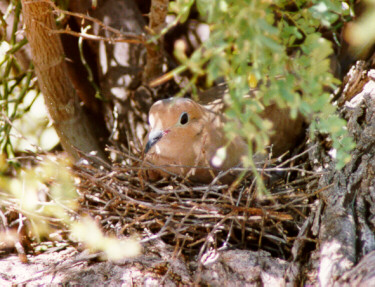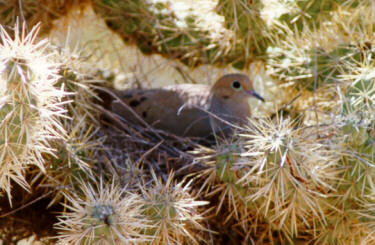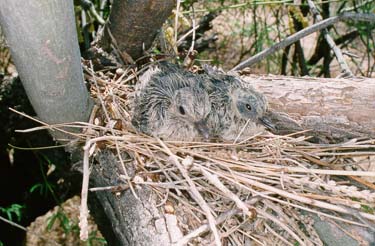Mourning Dove on nest, eggs, and baby birds in nest photographs
Updated May 27,1999
Photos by Greg Clark, May 1998
 The Mourning Dove is one of North America's most common birds. Renowned both for its flimsy nests and creative nest sites, this bird is a common resident of forest woodlands, sonoran desert habitats, agricultural areas with scattered trees, and surburbs. A close nest sitter, one of the easiest ways to find a nest for this bird is to walk under tree branches or near shrubs until the bird flushes from the nest a few feet from your head. At the sound of the whistling wings of the departing bird, begin your search for a nest that looks like a small bunch of twigs that just happen to be resting on a forked branch of the tree. In Arizona we are now used to finding nests in places that defy reason. Shown on this page are two typical nests with an adult in place incubating eggs. In addition to horizonal branches, the birds favor the top surface where a branch has broken off or inside the protective arms of a cholla cactus. One time I approached a Curve-billed Thrasher nest in a cholla cactus fully expecting a thrasher, only to find a Mourning Dove inside the mass of sticks. Tim discovered a nest on the end of a tree limb that had fallen from the tree and was resting against a fence. The dove was content to build her nest on the inclined stump end of a 3 inch branch that was ready to fall to the ground at any moment.
The Mourning Dove is one of North America's most common birds. Renowned both for its flimsy nests and creative nest sites, this bird is a common resident of forest woodlands, sonoran desert habitats, agricultural areas with scattered trees, and surburbs. A close nest sitter, one of the easiest ways to find a nest for this bird is to walk under tree branches or near shrubs until the bird flushes from the nest a few feet from your head. At the sound of the whistling wings of the departing bird, begin your search for a nest that looks like a small bunch of twigs that just happen to be resting on a forked branch of the tree. In Arizona we are now used to finding nests in places that defy reason. Shown on this page are two typical nests with an adult in place incubating eggs. In addition to horizonal branches, the birds favor the top surface where a branch has broken off or inside the protective arms of a cholla cactus. One time I approached a Curve-billed Thrasher nest in a cholla cactus fully expecting a thrasher, only to find a Mourning Dove inside the mass of sticks. Tim discovered a nest on the end of a tree limb that had fallen from the tree and was resting against a fence. The dove was content to build her nest on the inclined stump end of a 3 inch branch that was ready to fall to the ground at any moment. 
The nest in the cholla cactus on the left was so close to the road that it is possible to reach out of the car window and touch it without raising out of your seat. In fact, one has to be careful not to brush the cactus with your car and thus disturb the nest. We have found nests on the edges of rock walls and on beams holding up porch ceilings. Over the last five years we have found nests everywhere except in the one place they are never supposed to be found nesting. It has been the conventional wisdom that Mourning Doves never nest on the ground. Oh, they might nest sort-of on the ground, but you will always see that there is a some elevation present so that the nest is overlooking the ground below, even if "overlooking" is only a few inches. For years we agreed with this assessment, we had only found one nest that was on the ground, but it sat on a rock on a gentle slope leading to a dry wash. However, this year we finally found a nest on truly dead-flat ground. View the nest on the ground.
 Baby Mourning Doves on a nest in a mesquite tree, this photo was taken May 22, 1999 in south-central Arizona.
Baby Mourning Doves on a nest in a mesquite tree, this photo was taken May 22, 1999 in south-central Arizona.
Copyright Greg Clark, 1998
update 8/2012